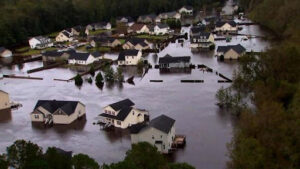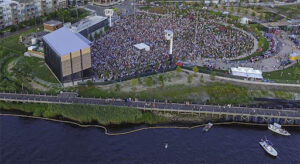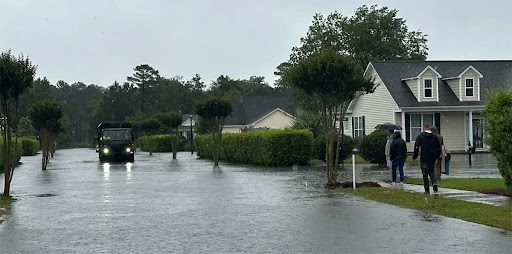Amidst the serene coast of North Carolina, where the boundless beauty of the Atlantic collides with the ever-encroaching specter of climate change, residents are confronted by an escalating menace: flooding. With rising sea levels and intensifying storms, the demand for advanced floodproofing techniques has reached a critical juncture.
As they navigate this fragile intersection of natural allure and environmental challenges, the ingenuity and resilience of Coastal North Carolina residents shine as a beacon of hope in the face of an increasingly uncertain future.
Understanding the Coastal North Carolina Flooding Challenge
 Image Source: ABC News
Image Source: ABC News
The coastal region of North Carolina grapples with a long history of severe flooding events. Hurricane Florence in 2018 serves as a grim example, causing widespread devastation and highlighting the region’s vulnerability. However, climate change has further compounded the situation, leading to rising sea levels and more intense storms. These factors collectively pose an ever-increasing risk for coastal communities.
To address this, FEMA has established flood zone classifications, varying from high-risk Special Flood Hazard Areas (SFHAs) to moderate-to-low-risk zones. These classifications guide flood proofing measures and insurance requirements, especially for homeowners in SFHAs. In the face of these challenges, Coastal North Carolina is adapting, embracing innovative floodproofing techniques to protect its communities and ensure a resilient future.
Conventional Flood Proofing Measures
In Coastal North Carolina, homeowners can employ a set of conventional flood proofing measures to confront the persistent risks associated.
A. Elevating Homes: Piers and Pilings
Elevating homes on sturdy pilings and columns is a widely adopted practice, reducing damage and offering spectacular coastal views. This method has proven effective, protecting homes against rising tides and intense storms.
B. Flood-Resistant Materials and Construction Techniques
Selecting flood-resistant materials and construction techniques is crucial. Reinforced concrete, impact-resistant windows, and elevated electrical systems strengthen homes against the corrosive effects of saltwater and storm damage.
C. Flood Insurance and Its Importance
Flood insurance is a vital component. Especially in FEMA-designated Special Flood Hazard Areas (SFHAs), it provides financial security in the event of flood damage, easing the recovery process and mitigating potential financial ruin.
Advanced Flood Proofing Techniques
 Image Source: Libelium
Image Source: Libelium
As Coastal North Carolina confronts the escalating challenges of flooding, innovative solutions have emerged, pushing the boundaries of flood proofing capabilities. These advanced flood proofing techniques combine modern technology and eco-conscious design to offer heightened protection.
A. Innovative Foundation Designs
Flood-Resistant Concrete: Cutting-edge foundation materials are revolutionizing flood proofing. This special concrete is specially engineered to withstand the corrosive nature of saltwater and the pressure the water can cause. This durable material minimizes damage and ensures the structural integrity of homes even in the harshest flood conditions.
Elevated Basements: Elevated basements challenge traditional thinking, providing a unique and adaptable solution to flood proofing. This approach combines the benefits of elevated living spaces with basement functionality, offering homeowners the versatility of an extra living area that remains secure during floods.
B. Smart Home Technologies for Flood Monitoring and Prevention
IoT Sensors and Flood Alert Systems: In an age of interconnectedness, smart home technologies have made significant inroads in flood protection. Internet of Things (IoT) sensors are strategically placed to monitor water levels and send real-time data to homeowners. Flood alert systems offer immediate notifications, allowing residents to take timely action, move valuables to safety, or activate defenses.
Automatic Flood Barriers: Automatic flood barriers represent an ingenious leap in flood proofing. These barriers deploy automatically when sensors detect rising water levels, creating a watertight seal around a property. This proactive approach significantly reduces damages by preventing water infiltration before it occurs.
C. Green Infrastructure for Flood Mitigation
 Image Source: Better Homes & Gardens
Image Source: Better Homes & Gardens
Rain Gardens and Permeable Pavements: Beyond technology, green infrastructure plays a pivotal role in flood mitigation. Rain gardens and permeable pavements are environmentally friendly techniques that help manage stormwater. Rain gardens, filled with native vegetation, absorb and filter water, while permeable pavements allow water to seep into the ground, reducing risks.
Vegetative Swales and Bio-Retention Ponds: Coastal communities are also turning to vegetative swales and bio-retention ponds as natural safeguards. Vegetative swales, or channels filled with vegetation, slow down and redirect stormwater, preventing it from overwhelming drainage systems. Bio-retention ponds act as natural reservoirs, absorbing and purifying stormwater while reducing flood risks.
These advanced flood proofing techniques mark a significant step forward in Coastal North Carolina’s resilience against flooding. They showcase the synergy between innovation and environmental consciousness, offering homeowners the means to protect their homes and the surrounding ecosystem comprehensively and sustainably. As the region faces mounting flood threats, these techniques illuminate a path toward a more secure and environmentally harmonious future.
Cost-Benefit Analysis
For Coastal North Carolina homeowners considering advanced flood proofing, a careful cost-benefit analysis is essential. Although the initial investment may be substantial, the long-term financial benefits are significant. Flood-resistant measures like elevation and smart technology reduce damage, leading to lower repair costs and insurance discounts, which enhance financial stability.
Government programs in the region provide financial support to encourage further flood proofing, including grants for elevation, low-interest loans for materials, and tax incentives for technology integration. These incentives make it more accessible and underscore the region’s commitment to flood resilience. Insurance discounts for flood proofed homes further alleviate costs, ultimately making these measures a prudent financial decision for Coastal North Carolina homeowners.
The Role of Community and Local Government
 Image Source: Pew
Image Source: Pew
The collective efforts of local government and the community play a critical role in enhancing Coastal North Carolina’s resilience against flooding.
Local government regulations are pivotal in shaping flood proofing standards. These codes mandate flood-resistant construction techniques and materials in flood-prone areas, ensuring the safety of homes and promoting safe building practices. By enforcing strict building standards, the local government guides homeowners in constructing and renovating properties, reducing risks, and minimizing damage.
Community-based approaches involve collaborative efforts to address flood risk collectively. These initiatives encourage knowledge sharing, emergency response planning, and mutual support during flood events. By uniting residents, local organizations, and government agencies, these programs strengthen the community’s overall ability to withstand and recover from floods, emphasizing the importance of a shared commitment to flood resilience.
Public-private partnerships harness the strengths of government entities and private sector organizations. Collaborations between insurance companies, technology providers, and construction firms are driving innovation and enhancing flood proofing initiatives.
For instance, insurance companies offer incentives to homeowners to adopt advanced flood proofing measures, and technology providers develop innovative flood monitoring systems. These partnerships are making floodproofing more accessible and affordable while increasing Coastal North Carolina’s resilience against flood threats. Together, these efforts shape a more secure future for coastal communities.
Future Trends in Flood Proofing
The future of flood proofing in Coastal North Carolina is marked by innovation and adaptability. New construction materials and advanced technologies are shaping the future of flood proofing. Flood-resistant materials and smart sensors offer a more proactive approach to flood detection and prevention. Automatic flood barriers are revolutionizing the way homes can withstand rising water levels. These innovations provide homeowners with smarter, more resilient floodproofing options.
In addition, coastal communities in North Carolina are focusing on adapting to a changing climate. Resilient infrastructure, the restoration of natural coastal buffers, and sustainable landscapes are becoming central to community-wide efforts. This approach mitigates flood risk and nurtures the region’s ecological health, making it better prepared for the challenges of a shifting climate.
The future of flood proofing also emphasizes sustainable and resilient coastal housing. This involves eco-friendly architecture and urban planning, incorporating green infrastructure like rain gardens and vegetative swales. Additionally, homes are increasingly integrated with sustainable energy solutions, fostering flood resilience and ecological responsibility. The vision is one of coexistence with nature, where homes are safe, sustainable, and in harmony with the coastal environment.
In summary, the future of floodproofing in Coastal North Carolina is about embracing innovation, climate adaptation, and sustainable housing solutions. These forward-thinking approaches aim to secure a resilient future for the region, where residents can live safely and sustainably in the face of evolving flood challenges.
Final Thoughts
Coastal North Carolina stands at the forefront of resilience against coastal flooding, introducing advanced flood proofing techniques that protect homes and envision a sustainable and secure future. These innovations empower homeowners to withstand nature’s challenges. Alongside climate adaptation strategies and community-based initiatives, the region is fostering collective flood resilience. The vision of sustainable and resilient coastal housing embodies coexistence with nature, where ecological health and resilient homes thrive together. As Coastal North Carolina forges ahead, it offers a beacon of hope and innovation for vulnerable communities worldwide grappling with coastal flooding.



Leave a Reply